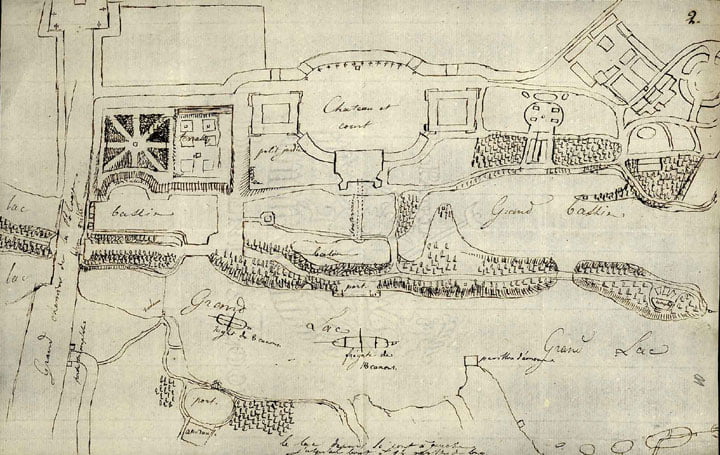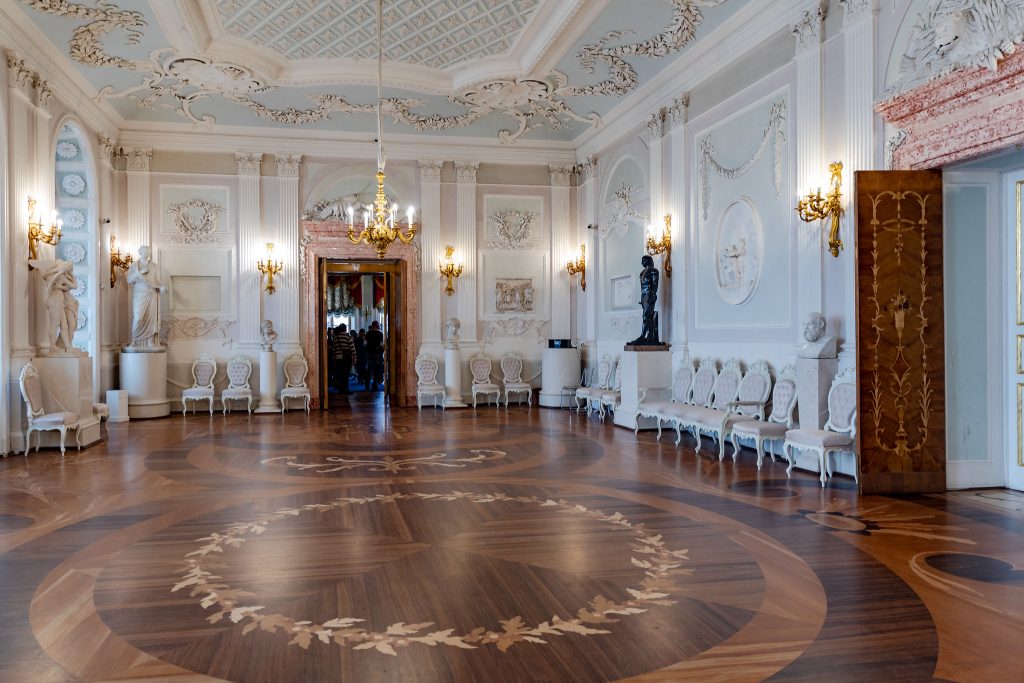Prepare to stride through corridors of Renaissance grandeur and take refreshing walks through lush parks – for that is what you will find waiting at Gatchina Palace in Gatchinsky, Russia. Whether you take a guided tour or venture on your own, the palace will provide you with the experience of a lifetime. Below is everything you need to know about its history, current condition, and ways to get there:
Table of Contents
Palace interiors were given a huge overhaul in the 1790s by Vincenzo Brenna, who installed Baroque-style architectural pieces, classical carvings, moldings, tapestries, and drapes in the castle halls.

Frequently Asked Questions
Where is Gatchina Castle Located?
The Great Gatchina Palace stands in the Gatchinsky District, 28 miles southwest of St. Petersburg in Leningrad Oblast, Russia.
When was Gatchina Castle Built? Who Build It?
The famous Italian architect Rinaldi built the palace between 1766 and 1781.
When is The Best Time to Visit the Castle?
The best time to visit the castle is the warm months between mid-June and September.
What Other Monuments are Located Nearby?
While you’re in the city, you can also visit the Stella Gatchina or the Connetable Obelisk.
FOR HISTORY | BEAUTIFUL IMAGES | INTERESTING FACTS | TRAVEL TIPS
Early History
Construction and Early Years (18th Century)
Prince Boris Kurakin Count Grigory Orlov was responsible for the initial construction of Gatchina Palace. He was a favorite of Catherine’s for having orchestrated the assassination of her late husband, Peter III, which brought Catherine I to power.
The construction of Gatchina took almost fifteen years, the palace became the first in St. Petersburg’s suburbs. Orlov passed away only two years after the construction was completed, in 1783. After his death, Catherine purchased the palace from his heirs and endowed it to her son and future Tsar Paul I.
Paul I invested in the palace and rebuilt much of it, adding parks, pavilions, gateways, and bridges. After Paul I died, the castle came into the possession of his wife Maria Feodorovna, who commissioned architect Nikiforovich to make alterations to the palace to optimize it as a winter residence.

The Reign of Tsar Nicholas
In the 1840s, the castle came under the possession of Tsar Nicholas I. He redesigned much of the palace’s grounds, installing basement levels underneath and renovating the decor. An extra story was added on top of buildings surrounding the main square. In 1850, a commemorative sculpture for Paul I was added to the parade grounds.
Development (19th Century)
Gatchina was connected to St Petersburg via a railway track in 1854; the same year, the city’s parameters were broadened, integrating a lot of villages in the city’s periphery.
In 1855, the palace was inherited by Alexander II. The emperor used it as his second residence and established hunting grounds in the wilderness. He also updated the palace up until he was murdered in 1881. After being advised that he would be safer in Gatchina rather than the Winter Palace, Alexander’s successor spent most of his life here.

The palace came to be known as “The Citadel of Autocracy” based on the reactionary policies laid down by Alexander III. In Gatchina Palace, he signed bills and held diplomatic meetings, theatrical productions, and balls for entertainment. During Alexander III’s era, modern technology was set up in the palace, including telephones, insulated water supply, advanced sewage system, lights, and heating systems. After him, his wife became the patron of the palace, its grounds, and the city.
The Russian Revolution (Early 20th Century)
In 1917, Alexander III’s son Nicolas II was forced to abdicate as part of the Russian Revolution, which made Gatchina Palace state property. The palace was converted into a museum and served as a headquarters for troops against the Bolsheviks during the Russian Civil War.
In 1917, Imperial Russian troops led by Alexander Kerensky and Pyotr Krasnov retreated into the castle after being stopped by the Bolshevik army at Pulkovo Heights. Later, Krasnov was arrested while Kerensky escaped under the guise of a sailor. The castle was once again established as a museum in 1918. The palace became a battleground for a fight between the red and white armies, in which the white army was defeated. Red soldiers who passed away in battle were laid to rest on the parade grounds.

Revisit More Historic Places Below or Read Further
Current Times
The castle was again turned back into a museum until the German invasion in World War II. The war damaged much of the castle through shelling and aerial bombardment. German forces occupied the palace estate up until 1944 when the forces had to retreat. They set fire to the property as they left, leading it to face much damage.
Restoration work started in 1948 while the castle was used by the Naval Academy of the USSR and later the All-Union Research Institute. Renovations continued, and finally, in 1985, the castle was opened to the public for visitation, In 1990, the castle became recognized as a World Heritage Site by UNESCO. It’s been a popular tourist site as well as a set for numerous period dramas and movies since then.

The castle is currently a heritage site recognized by UNESCO and serves as a high-traffic museum and public park. It has also served as a set for numerous period dramas and movies such as the television adaptation of Tolstoy’s War and Peace.
Interesting Gatchina Castle Facts
- Gatchina has been a shooting site for a biopic based on Tsar Paul I called Poor Poor Paul (2003) as well as War and Peace (2016).
- The palace was destroyed in a fire during the Second World War, the reparations for which continue to this day.
- An overwhelming 21,000 tourists visited Gatchina in 1921.
- Palace interiors were given a huge overhaul in the 1790s by Vincenzo Brenna, who installed Baroque-style architectural pieces, classical carvings, moldings, tapestries, and drapes in the castle halls.
- There are over 600 rooms in the palace.
Visiting Gatchina Castle – Tips and Tricks
As one of the most monumental buildings in St. Petersburg, Gatchina Palace is certainly worth visiting. Here’s all you need to know about planning the perfect visit:

How to get to Gatchina Castle?
You can get to Gatchina Palace from Moscow via train, aeroplane, or car. The recommended method is via train. You can board the train from Moskva Kurskaya and ride to St. Petersburg Glavny. From there, you can board the subway at Ploshchad Vosstaniya and get off at Baltiyskaya. Finally, you will need to board the train from St. Petersburg Baltiyskaya Station and get off at Tat’yana, where the palace is a 30-minute walk away. The journey will take around 6 hours and 15 minutes and cost you between €29-€47.5 ($29 – $47 USD).
The second means to get to the palace is via car. The journey will take you around 7h 12m, and the fuel can cost you between €57.5 – €83 ($57 – $82 USD).
If you wish to go by air, you can board the plane from Moscow Sheremetyevo (SVO) and get off at Pulkovo airport. From there, you’ll take the bus to the Aeroport platform and then board the train to Tat’yana. From there onwards, the castle is about half an hour’s walk away. The journey is expected to take around 5 hours and 40 minutes and will cost you between EUR €26-€257 ($26 – $254 USD).
Ticket Prices, Visiting Hours & Travel Tips
Information was checked & updated on November 5, 2023.
The palace is open from 10:00 am to 6:00 pm except for Mondays and the first Tuesday of each month.
The Gatchina estate has a range of different ticket costs, so you can choose which areas you want to explore. Tickets to Gatchina Palace alone are 500 roubles ($8 USD) for adults, 275 roubles ($3 USD) for students, and for a family of two adults and kids, it’s 1200 roubles ($19 USD). The Priory Palace alone costs 250 roubles ($4 USD) for adults, 125 roubles ($2 USD) for students, and 650 roubles ($11 USD) for families. A combined ticket for both palaces can be purchased for discounted prices, at 650 roubles ($11 USD) for adults, 325 roubles ($6 USD) for students, and 1600 roubles ($26 USD) for families.
If you are more interested in gardens and external structures, then a ticket to visit Gatchina Palace and its surrounding parks might be better suited. The prices are: for adults, 650 roubles ($11 USD); for students, 325 roubles ($6 USD); and for families, 1600 roubles ($26 USD). Visiting the Venus Pavilion or the Birch House can each be purchased for 100 roubles ($1.6 USD) per adult or 50 roubles ($0.8 USD) per student. A tour of the Private Garden or visiting the Signal Tower are 150 roubles ($2.5 USD) per adult or 75 roubles ($1.2 USD) per student, respectively.

Tours of the Parks, the Venus Pavilion, the Private Garden, the Birch House, and the Signal Tower are only available during the summer from the 1st of May to the 15th of October.
You can also get guided tours of the Gatchina and Priory Palaces along with the parks in English, German or French. For Gatchina Palace, a guided tour costs €44 ($44 USD), while a guided tour of the Priory Palace will cost you €41 ($40 USD). You can also opt to take a combined guided tour of the Gatchina Palace and its surrounding parks, which will cost you €66 ($65 USD)
How Long Will It Take to Tour Around?
The guided tour of Gatchina Palace takes an hour and 50 minutes, you can take an extra hour to venture around its beautiful grounds on your own. Plan for longer if you want to visit the external structures and Priory Palace as well.
Up to Date Information
For up to date ticket prices and visiting hours visit the official website: https://gatchinapalace.ru/en/
Some words of advice and tips:
- Check the website to align your visit with one of the frequent events and exhibitions that take place at the castle.
- The private parks are a great site for couples to take a refreshing romantic stroll.
- Book your guided tour in advance to avoid any issues on arrival.
- You’ll want to spend at least 3 hours on-site in order to explore it fully.



